Dimensional Optimization of TiO2 Nanodisk Photonic Crystals on Lead Iodide (MAPbI3) Perovskite Solar Cells by Using FDTD Simulations
Abstract
:1. Introduction
2. Materials and Methods
3. Results and Discussion
3.1. Structure and Design
3.2. Optical Performances
4. Conclusions
Author Contributions
Funding
Acknowledgments
Conflicts of Interest
References
- Yan, J.; Saunders, B. Third-generation solar cells: A review and comparison of polymer: Fullerene, hybrid polymer and perovskite solar cells. RSC Adv. 2014, 4, 43286–43314. [Google Scholar] [CrossRef]
- Kojima, A.; Teshima, K.; Shirai, Y.; Miyasaka, T. Organometal Halide Perovskites as Visible-Light Sensitizers for Photovoltaic Cells. J. Am. Chem. Soc. 2009, 131, 6050–6051. [Google Scholar] [CrossRef] [PubMed]
- Kim, H.-S.; Lee, C.-R.; Im, J.-H.; Lee, K.-B.; Moehl, T.; Marchioro, A.; Moon, S.-J.; Humphry-Baker, R.; Yum, J.-H.; Moser, J.E.; et al. Lead Iodide Perovskite Sensitized All-Solid-State Submicron Thin Film Mesoscopic Solar Cell with Efficiency Exceeding 9%. Sci. Rep. 2012, 2, 591. [Google Scholar] [CrossRef] [PubMed] [Green Version]
- Sahoo, S.K.; Manoharan, B.; Sivakumar, N. Introduction: Why perovskite and perovskite solar cells? In Perovskite Photovoltaics; Academic Press: Cambridge, MA, USA, 2018. [Google Scholar]
- Jeyakumar, R.; Bag, A.; Nekovei, R.; Radhakrishnan, R. Interface studies by simulation on methylammonium lead iodide based planar perovskite solar cells for high efficiency. Sol. Energy 2019, 190, 104–111. [Google Scholar] [CrossRef]
- Tseng, C.-C.; Chen, L.-C.; Chang, L.-B.; Wu, G.-M.; Feng, W.-S.; Jeng, M.-J.; Chen, D.W.; Lee, K.-L. Cu2O-HTM/SiO2-ETM assisted for synthesis engineering improving efficiency and stability with heterojunction planar perovskite thin-film solar cells. Sol. Energy 2020, 204, 270–279. [Google Scholar] [CrossRef]
- Singh, N.; Agarwal, A.; Agarwal, M. Numerical simulation of highly efficient lead-free perovskite layers for the application of all-perovskite multi-junction solar cell. Superlattices Microstruct. 2021, 149, 106750. [Google Scholar] [CrossRef]
- Badrooj, M.; Jamali-Sheini, F.; Torabi, N. Roles of Sn content in physical features and charge transportation mechanism of Pb-Sn binary perovskite solar cells. Sol. Energy 2020, 209, 590–601. [Google Scholar] [CrossRef]
- Shahverdi, N.; Yaghoubi, M.; Goodarzi, M.; Soleamani, A. Optimization of anti-reflection layer and back contact of Perovskite solar cell. Sol. Energy 2019, 189, 111–119. [Google Scholar] [CrossRef]
- Haque, S.; Mendes, M.J.; Sanchez-Sobrado, O.; Águas, H.; Fortunato, E.; Martins, R. Photonic-structured TiO2 for high-efficiency, flexible and stable Perovskite solar cells. Nano Energy 2019, 59, 91–101. [Google Scholar] [CrossRef]
- Shelby, R.A.; Smith, D.R.; Schultz, S. Experimental Verification of a Negative Index of Refraction. Science 2001, 292, 77–79. [Google Scholar] [CrossRef] [Green Version]
- Baba, T. Slow light in photonic crystals. Nat. Photonics 2008, 2, 465–473. [Google Scholar] [CrossRef]
- Chen, J.I.L.; von Freymann, G.; Choi, S.Y.; Kitaev, V.; Ozin, G.A. Slow photons in the fast lane in chemistry. J. Mater. Chem. 2008, 18, 369–373. [Google Scholar] [CrossRef]
- John, S. Light trapping and solar energy harvesting with 3D photonic crystals. In Proceedings of the IEEE Photonics Conference 2012, Burlingame, CA, USA, 23–27 September 2012; Volume 3, p. 126. [Google Scholar] [CrossRef]
- Zhenhua, W. Back Reflector of Solar Cells Consisting of One-dimensional Photonic Crystal and Double-layered Two-dimensional Photonic Crystal. Acta Photonica Sin. 2016, 45, 223003. [Google Scholar] [CrossRef]
- Choi, D.H.; Nam, S.K.; Jung, K.; Moon, J.H. 2D photonic crystal nanodisk array as electron transport layer for highly efficient perovskite solar cells. Nano Energy 2019, 56, 365–372. [Google Scholar] [CrossRef]
- Yang, D.; Zhou, X.; Yang, R.; Yang, Z.; Yu, W.; Wang, X.; Li, C.; Liu, S.; Liu, S. (Frank); Chang, R.P.H. Surface optimization to eliminate hysteresis for record efficiency planar perovskite solar cells. Energy Environ. Sci. 2016, 9, 3071–3078. [Google Scholar] [CrossRef]
- Choi, J.; Song, S.; Hörantner, M.T.; Snaith, H.; Park, T. Well-Defined Nanostructured, Single-Crystalline TiO2 Electron Transport Layer for Efficient Planar Perovskite Solar Cells. ACS Nano 2016, 10, 6029–6036. [Google Scholar] [CrossRef] [PubMed]
- Ko, D.-H.; Tumbleston, J.R.; Zhang, L.; Williams, S.; DeSimone, J.M.; Lopez, R.; Samulski, E.T. Photonic Crystal Geometry for Organic Solar Cells. Nano Lett. 2009, 9, 2742–2746. [Google Scholar] [CrossRef]
- Zhangyang, X.; Liu, L.; Lv, Z.; Lu, F.; Tian, J. Comparative analysis of light trapping GaN nanohole and nanorod arrays for UV detectors. J. Nanopart. Res. 2020, 22, 1–10. [Google Scholar] [CrossRef]
- De Zoysa, M.; Ishizaki, K.; Tanaka, Y.; Sai, H.; Matsubara, K.; Noda, S. Enhanced efficiency of ultrathin (∼500 nm)-film microcrystalline silicon photonic crystal solar cells. Appl. Phys. Express 2016, 10, 012302. [Google Scholar] [CrossRef]
- Kim, D.I.; Lee, J.W.; Jeong, R.H.; Yu, J.-H.; Yang, J.W.; Nam, S.-H.; Boo, J.-H. Enhancing the optical properties using hemisphere TiO2 photonic crystal as the electron acceptor for perovskite solar cell. Appl. Surf. Sci. 2019, 487, 409–415. [Google Scholar] [CrossRef]
- Liu, Z.; Wu, L.; Wang, X.; Xu, Q.; Hu, Y.; Meng, K.; Chen, G. Improving efficiency and stability of colorful perovskite solar cells with two-dimensional photonic crystals. Nanoscale 2020, 12, 8425–8431. [Google Scholar] [CrossRef]
- Ramos, F.J.; Oliva-Ramírez, M.; Nazeeruddin, M.K.; Graetzel, M.; González-Elipe, A.R.; Ahmad, S. Light management: Porous 1-dimensional nanocolumnar structures as effective photonic crystals for perovskite solar cells. J. Mater. Chem. A 2016, 4, 4962–4970. [Google Scholar] [CrossRef]
- Du, Q.G.; Shen, G.; John, S. Light-trapping in perovskite solar cells. AIP Adv. 2016, 6, 065002. [Google Scholar] [CrossRef]
- Tavakoli, M.M.; Tsui, K.H.; Zhang, Q.; He, J.; Yao, Y.; Li, D.; Fan, Z. Highly Efficient Flexible Perovskite Solar Cells with Antireflection and Self-Cleaning Nanostructures. ACS Nano 2015, 9, 10287–10295. [Google Scholar] [CrossRef] [PubMed]
- Zhang, W.; Anaya, M.; Lozano, G.; Calvo, M.E.; Johnston, M.B.; Míguez, H.; Snaith, H.J. Highly Efficient Perovskite Solar Cells with Tunable Structural Color. Nano Lett. 2015, 15, 1698–1702. [Google Scholar] [CrossRef] [PubMed] [Green Version]
- Kang, S.M.; Jang, S.; Lee, J.-K.; Yoon, J.; Yoo, D.-E.; Lee, J.-W.; Choi, M.; Park, N.-G. Moth-Eye TiO2 Layer for Improving Light Harvesting Efficiency in Perovskite Solar Cells. Small 2016, 12, 2443–2449. [Google Scholar] [CrossRef]
- Wang, X.; Fujimaki, M.; Awazu, K. Photonic crystal structures in titanium dioxide (TiO2) and their optimal design. Opt. Express 2005, 13, 1486–1497. [Google Scholar] [CrossRef]
- Gwomei, W.U.; Ju, N.T.; Chang, T.W.; Feng, W.S. Study of two-dimensional photonic crystal arrays for beam splitters. Mater. Sci. 2016, 22, 218–222. [Google Scholar] [CrossRef] [Green Version]
- Palik, E.D. Handbook of Optical Constants of Solids; Academic Press: Cambridge, MA, USA, 2008. [Google Scholar]
- Green, M.A.; Jiang, Y.; Soufiani, A.M.; Ho-Baillie, A. Optical Properties of Photovoltaic Organic–Inorganic Lead Halide Perovskites. J. Phys. Chem. Lett. 2015, 6, 4774–4785. [Google Scholar] [CrossRef]
- Filipič, M.; Loeper, P.; Niesen, B.; De Wolf, S.; Krč, J.; Ballif, C.; Topic, M. CH_3NH_3PbI_3 perovskite / silicon tandem solar cells: Characterization based optical simulations. Opt. Express 2015, 23, A263–A278. [Google Scholar] [CrossRef] [Green Version]
- Raoult, E.; Bodeux, R.; Jutteau, S.; Rives, S.; Yaiche, A.; Coutancier, D.; Rousset, J.; Collin, S. Optical Characterizations and Modelling of Semitransparent Perovskite Solar Cells for Tandem Applications. In Proceedings of the 36th European Photovoltaic Solar Energy Conference and Exhibition, Marseille, France, 9–13 September 2019; Volume 36, pp. 757–763. [Google Scholar] [CrossRef]
- Heidarzadeh, H.; Rostami, A.; Dolatyari, M.; Rostami, G. Plasmon-enhanced performance of an ultrathin silicon solar cell using metal-semiconductor core-shell hemispherical nanoparticles and metallic back grating. Appl. Opt. 2016, 55, 1779–1785. [Google Scholar] [CrossRef] [PubMed]
- Zhou, D.; Zhou, T.; Tian, Y.; Zhu, X.; Tu, Y. Perovskite-Based Solar Cells: Materials, Methods, and Future Perspectives. J. Nanomater. 2018, 2018, 1–15. [Google Scholar] [CrossRef]
- Lee, K.-M.; Lin, W.-J.; Chen, S.-H.; Wu, M.-C. Control of TiO2 electron transport layer properties to enhance perovskite photovoltaics performance and stability. Org. Electron. 2020, 77, 105406. [Google Scholar] [CrossRef]
- Liu, W.; Ma, H.; Walsh, A. Advance in photonic crystal solar cells. Renew. Sustain. Energy Rev. 2019, 116, 109436. [Google Scholar] [CrossRef]
- Tanabe, K. A Review of Ultrahigh Efficiency III-V Semiconductor Compound Solar Cells: Multijunction Tandem, Lower Dimensional, Photonic Up/Down Conversion and Plasmonic Nanometallic Structures. Energies 2009, 2, 504–530. [Google Scholar] [CrossRef] [Green Version]
- Hörantner, M.T.; Zhang, W.; Saliba, M.; Wojciechowski, K.; Snaith, H.J. Templated microstructural growth of perovskite thin films via colloidal monolayer lithography. Energy Environ. Sci. 2015, 8, 2041–2047. [Google Scholar] [CrossRef]
- Chen, H.; Zhu, W.; Zhang, Z.; Cai, W.; Zhou, X. Er and Mg co-doped TiO2 nanorod arrays and improvement of photovoltaic property in perovskite solar cell. J. Alloy. Compd. 2019, 771, 649–657. [Google Scholar] [CrossRef]
- Meng, K.; Gao, S.; Wu, L.; Wang, G.; Liu, X.; Chen, G.; Liu, Z. Two-Dimensional Organic–Inorganic Hybrid Perovskite Photonic Films. Nano Lett. 2016, 16, 4166–4173. [Google Scholar] [CrossRef]
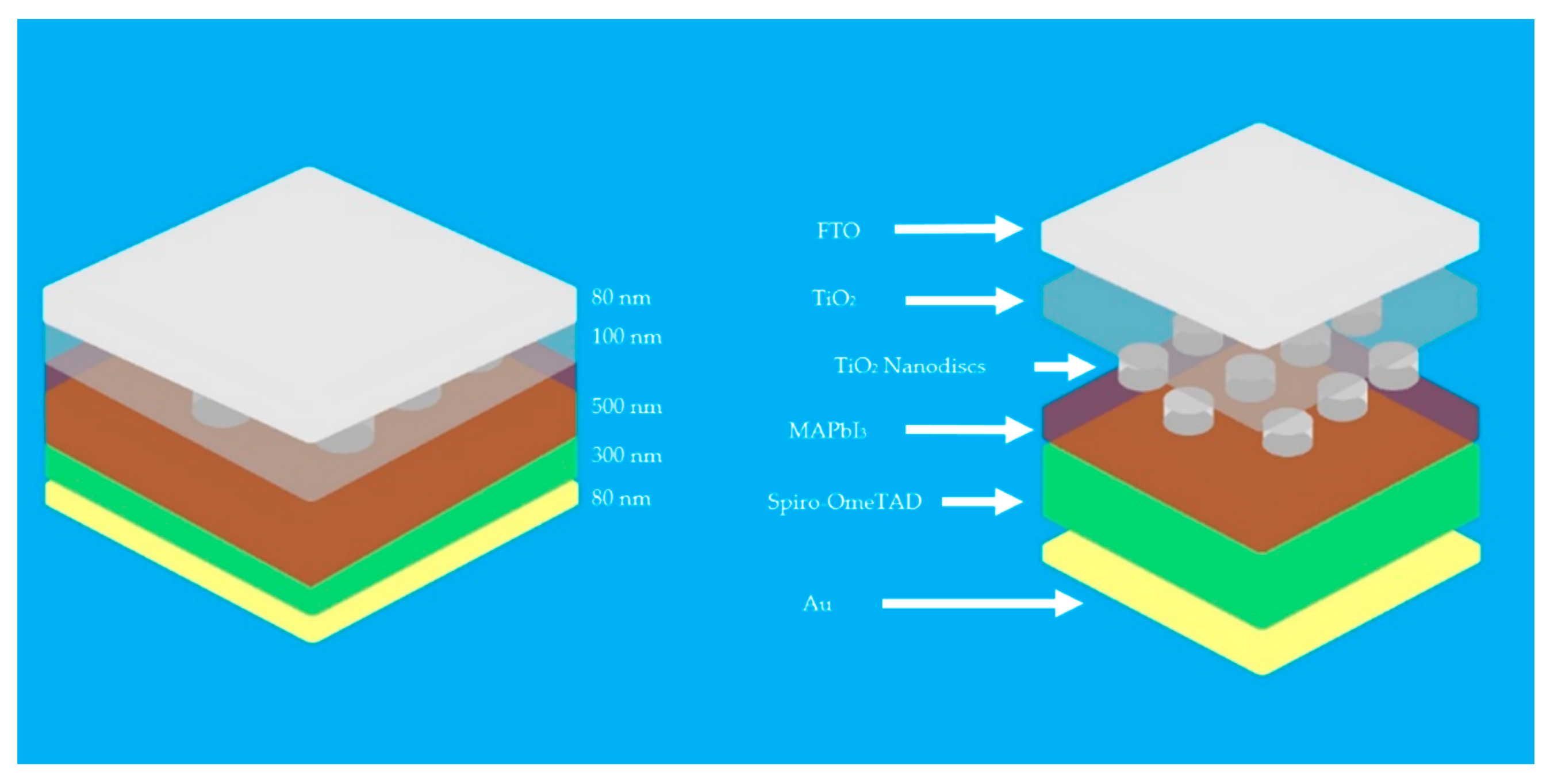

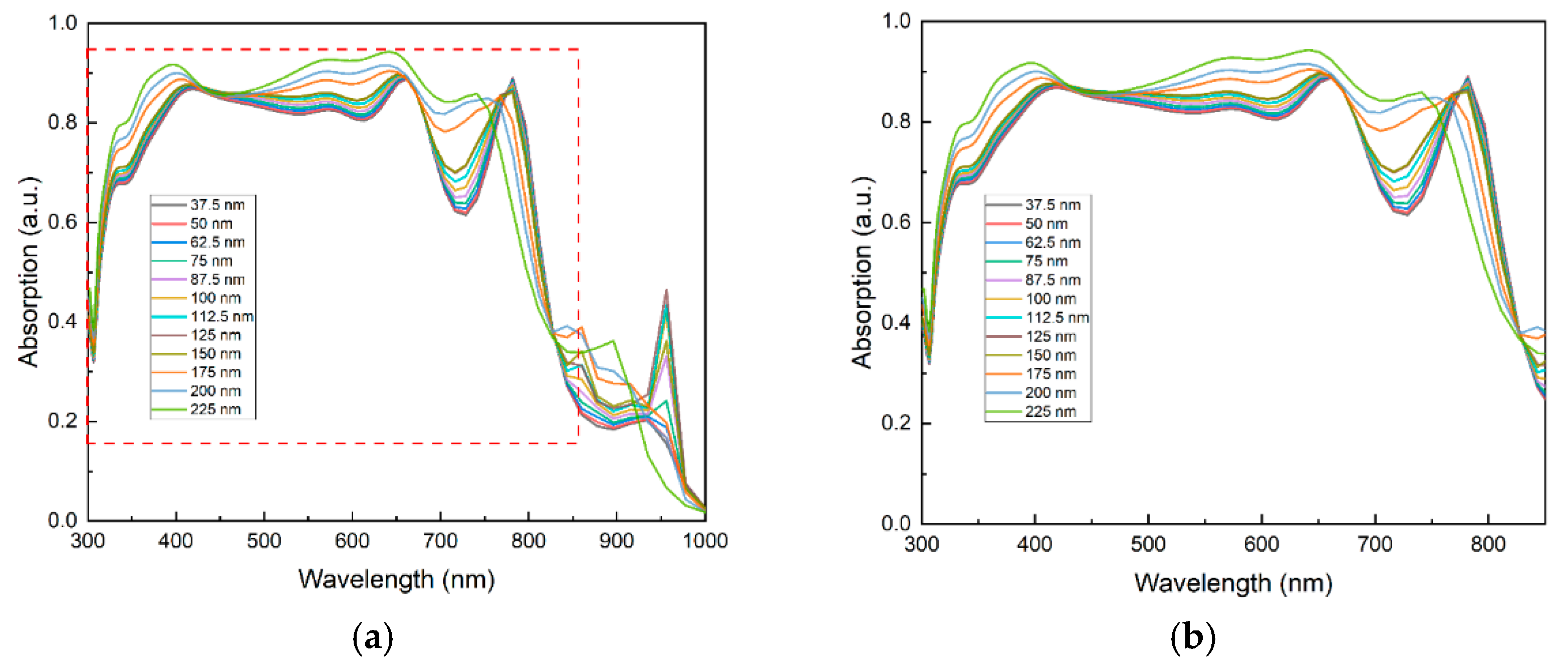
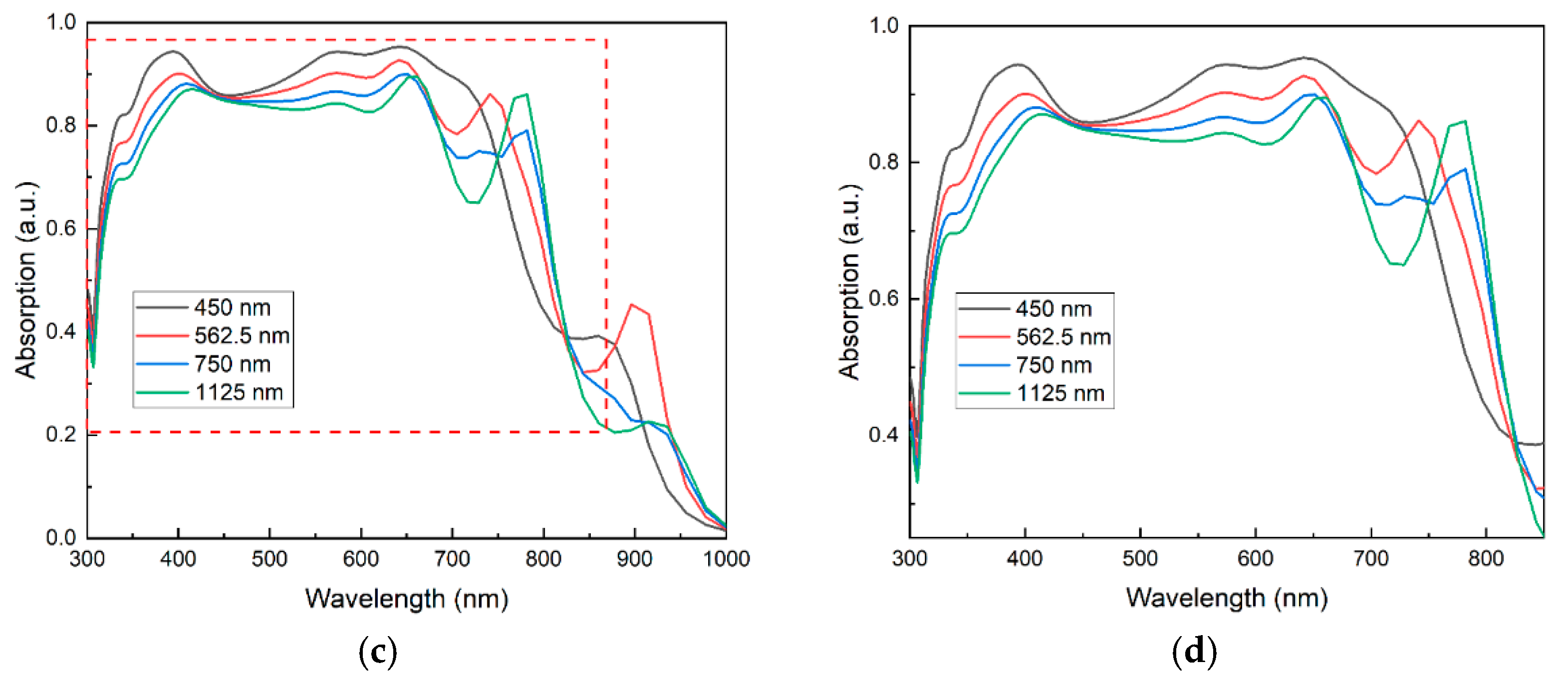
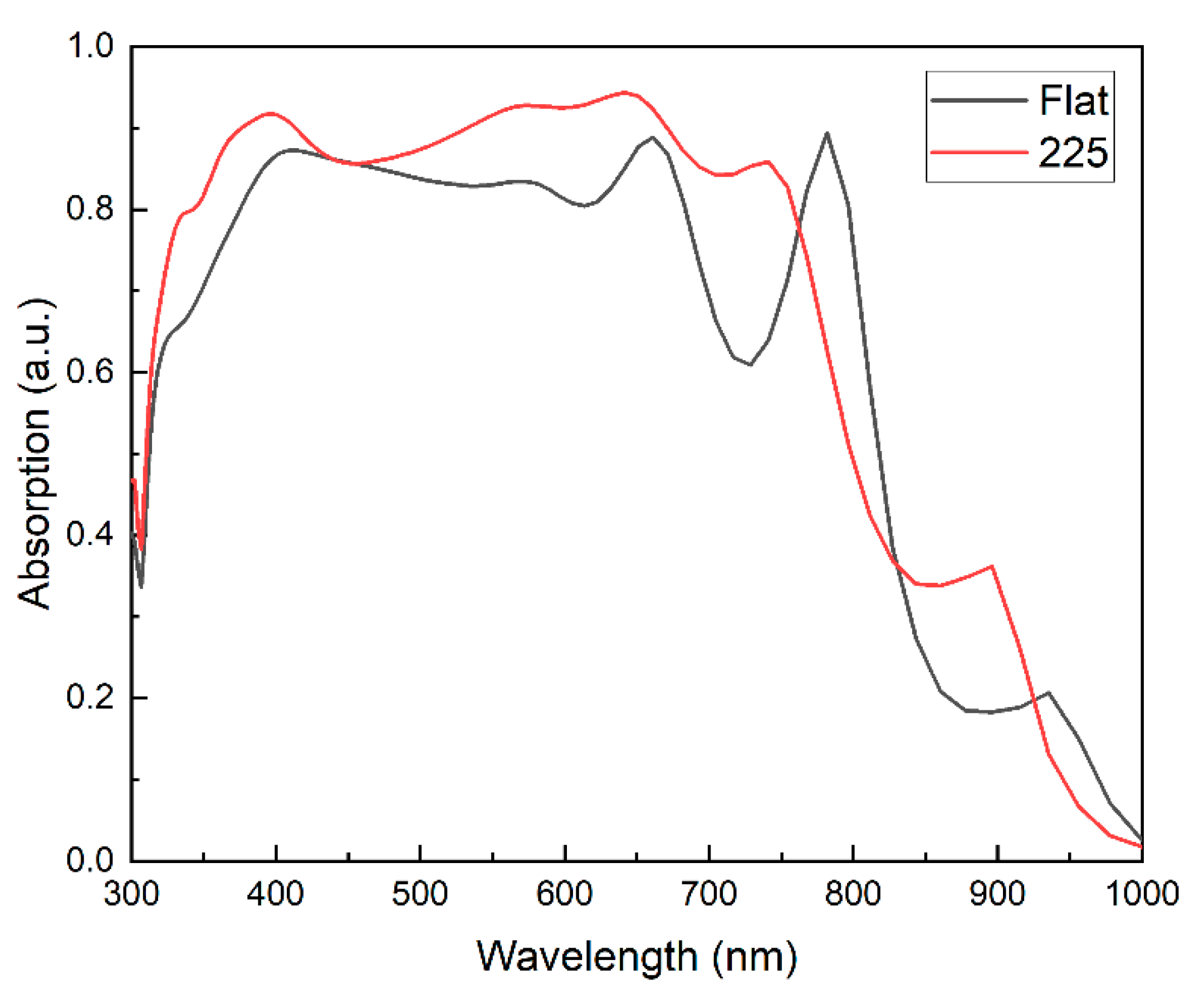
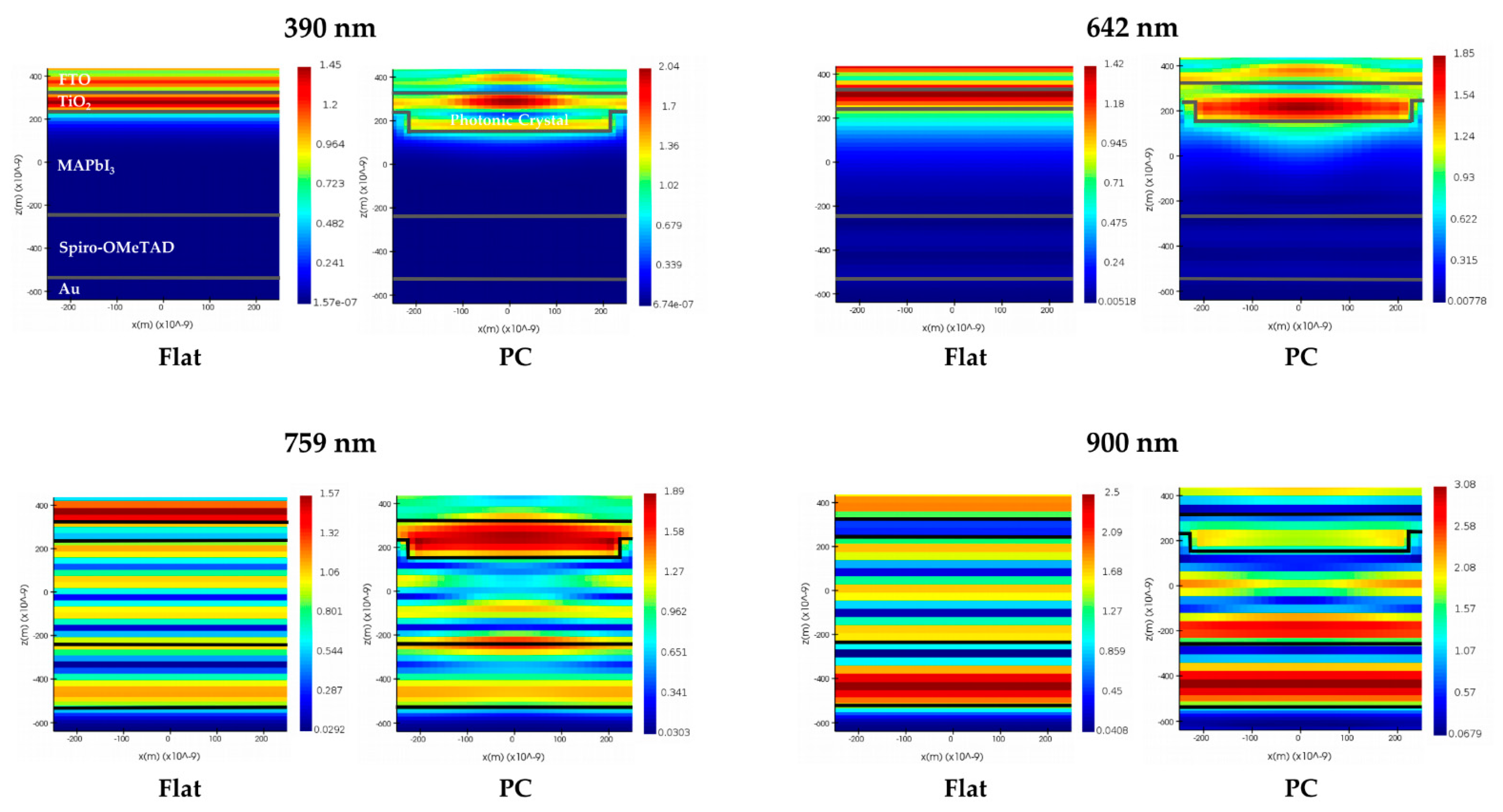
| Layer | Material | Size |
|---|---|---|
| Transparent Electrode | FTO (fluorine doped tin oxide) | 80 nm thick |
| Electron Transport (ETL) | TiO2 | 100 nm thick |
| Photonic Crystals | TiO2 | 100 nm thick, 37.5–225 nm radius, 450–1125 nm lattice constant |
| Perovskite | MAPbI3 | 500 nm |
| Hole Transport (HTL) | Spiro-OMeTAD | 300 nm |
| Metal Electrode | Au | 80 nm |
| r (nm) | a (nm) | Jsc (mA/cm2) |
|---|---|---|
| (Flat PSC) | (Flat PSC) | 24.470 |
| 50 | 500 | 24.659 |
| 100 | 25.428 | |
| 150 | 26.153 | |
| 200 | 26.467 | |
| 225 | 26.473 | |
| 225 | 450 | 26.251 |
| 562.5 | 26.187 | |
| 750 | 25.220 | |
| 1125 | 24.618 |
| Structure | PC Shape | Absorption | Jsc (mA/cm2) | Reference |
|---|---|---|---|---|
| FTO/TiO2/MAPbI3-xClx/Spiro-OmeTAD | Inverse Opal | 55% | 17.1 | [40] |
| FTO/TiO2/MAPbI3/Spiro-OmeTAD | Nanorod | 57% | 19.18 | [41] |
| FTO/TiO2/MAPbI3/Spiro-OmeTAD | Inverse Opal | 72% | 14.9 | [42] |
| FTO/TiO2/MAPbI3/Spiro-OmeTAD | Hemisphere | 82% | 26.5 | [22] |
| FTO/TiO2/MAPbI3/Spiro-OmeTAD | Nanodisk | 87% | 26.5 | This work |
Publisher’s Note: MDPI stays neutral with regard to jurisdictional claims in published maps and institutional affiliations. |
© 2021 by the authors. Licensee MDPI, Basel, Switzerland. This article is an open access article distributed under the terms and conditions of the Creative Commons Attribution (CC BY) license (https://creativecommons.org/licenses/by/4.0/).
Share and Cite
Hasanah, L.; Ashidiq, A.; Pawinanto, R.E.; Mulyanti, B.; Wulandari, C.; Wiendartun; Md. Zain, A.R. Dimensional Optimization of TiO2 Nanodisk Photonic Crystals on Lead Iodide (MAPbI3) Perovskite Solar Cells by Using FDTD Simulations. Appl. Sci. 2022, 12, 351. https://doi.org/10.3390/app12010351
Hasanah L, Ashidiq A, Pawinanto RE, Mulyanti B, Wulandari C, Wiendartun, Md. Zain AR. Dimensional Optimization of TiO2 Nanodisk Photonic Crystals on Lead Iodide (MAPbI3) Perovskite Solar Cells by Using FDTD Simulations. Applied Sciences. 2022; 12(1):351. https://doi.org/10.3390/app12010351
Chicago/Turabian StyleHasanah, Lilik, Adryan Ashidiq, Roer Eka Pawinanto, Budi Mulyanti, Chandra Wulandari, Wiendartun, and Ahmad Rifqi Md. Zain. 2022. "Dimensional Optimization of TiO2 Nanodisk Photonic Crystals on Lead Iodide (MAPbI3) Perovskite Solar Cells by Using FDTD Simulations" Applied Sciences 12, no. 1: 351. https://doi.org/10.3390/app12010351
APA StyleHasanah, L., Ashidiq, A., Pawinanto, R. E., Mulyanti, B., Wulandari, C., Wiendartun, & Md. Zain, A. R. (2022). Dimensional Optimization of TiO2 Nanodisk Photonic Crystals on Lead Iodide (MAPbI3) Perovskite Solar Cells by Using FDTD Simulations. Applied Sciences, 12(1), 351. https://doi.org/10.3390/app12010351







